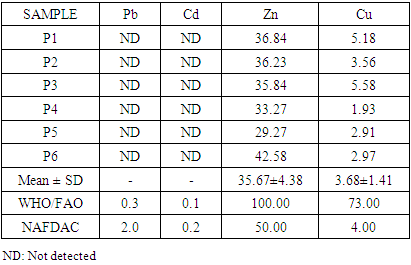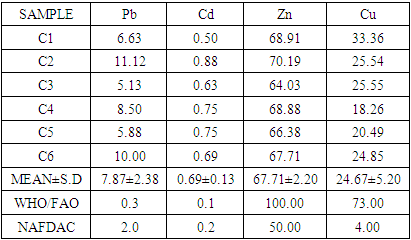-
Paper Information
- Paper Submission
-
Journal Information
- About This Journal
- Editorial Board
- Current Issue
- Archive
- Author Guidelines
- Contact Us
Advances in Analytical Chemistry
p-ISSN: 2163-2839 e-ISSN: 2163-2847
2021; 11(1): 9-12
doi:10.5923/j.aac.20211101.02
Received: Sep. 1, 2021; Accepted: Sep. 22, 2021; Published: Nov. 26, 2021

Bioaccumulation of Heavy Metals in Crab and Prawn Tissue from Ojo River, Ojo-Lagos
Olusegun S. Tunde 1, Ezeokoli C. Abigail 2, Fadimu O. Kehinde 3, Badmus W. Abolore 1, Olatunde A. Temidayo 1, Osundiya M. Olubunmi 1
1Department of Chemistry, Lagos State University, Lagos, Nigeria
2Department of Microbiology/Biochemistry, University of Nigeria, Enugu, Nigeria
3Department of Biochemistry, Federal University of Agriculture, Abeokuta, Nigeria
Correspondence to: Olusegun S. Tunde , Department of Chemistry, Lagos State University, Lagos, Nigeria.
| Email: |  |
Copyright © 2021 The Author(s). Published by Scientific & Academic Publishing.
This work is licensed under the Creative Commons Attribution International License (CC BY).
http://creativecommons.org/licenses/by/4.0/

This research was carried out to assess the extent of chemical contamination of the river ecosystem by man’s anthropogenic activities, and in turn the adverse effects of the chemical pollutants on man’s health. Therefore, the level of heavy metals' contamination from Pb, Cd, Zn and Cu in six crabs and prawn samples from Ojo River were assessed using atomic absorption spectrometer. Pb, and Cd were observed to have the mean concentration 24.67 ±5.20 μg/g, 7.78 ± 2.38 μg/g and 0.69±0.13 μg/g respectively with the highest mean level of concentrations (67.71 ± 2.20 μg/g) was found in Crab, while the least was Cd with 0.69±0.13 μg/g which were above NAFDAC permissible limits for aquatic foods. However, Pb and Cd were not detected in the prawn samples, with the Zn and Cu mean concentration of 35.67±4.38 and 3.68±1.41 μg/g respectively which are within the WHO/FAO and NAFDAC standard limits. The data gained from this experiment showed that crabs showed higher mean heavy metal concentration than prawn, hence, crabs are better bio- indicator of trace metals in a river ecosystem.
Keywords: Bio-indicator, Trace metals, Contamination, Ecosystem, Anthropogenic activities
Cite this paper: Olusegun S. Tunde , Ezeokoli C. Abigail , Fadimu O. Kehinde , Badmus W. Abolore , Olatunde A. Temidayo , Osundiya M. Olubunmi , Bioaccumulation of Heavy Metals in Crab and Prawn Tissue from Ojo River, Ojo-Lagos, Advances in Analytical Chemistry, Vol. 11 No. 1, 2021, pp. 9-12. doi: 10.5923/j.aac.20211101.02.
Article Outline
1. Introduction
- Bioaccumulation is a general term used to describe the total uptake of pollutants of which a living organism is exposed to in its environment. [1]. Bioaccumulation has been a useful tool for quantifying the extent of contamination of an aquatic ecosystem. Hence, living organism in an aquatic environment, obtain metals easily from either the water or the food chain [2]. Heavy metals can be accumulated by marine organisms through different pathways, including: respiration, adsorption and ingestion [3]. Olowu et a [2009] l reported that major the routes of heavy metals into the ecosystem is usually through anthropogenic activities of man, which include: metal complexes from local industries, mining, discharge of poorly or untreated industrial effluents as well as the unlawful use of chemicals on agricultural farmlands, e.g. fertilizers and pesticides [4]. These activities play an important role in the contribution of metal related health problems in man [5]. Accumulation of metals in a living organism is oftentimes used to evaluate the extent of pollution in a particular environment. The accumulation of heavy metals, however, depends on three important factors: the environmental concentrations, the species of organisms and the size or age or the feeding habit of the organism [6].Despite the favorable benefits of the consumption of marine foods, the carcinogenicity of heavy metals in crabs and prawns tend to pose risks to health of the consumers. Some heavy metals are referred to as essential micronutrients, the likes of Cu, Fe, Ni and Zn. However, Cd and Pb have no physiological activities [7]. Crustaceans, especially crabs and prawns are often used as biomarkers of the extent of surface water contamination. Certain internal organs as well as the nervous system of living organisms are often damaged as a result of the accumulation of metals in their body system, as metals are known for their non biodegradability [8]. Several studies have been carried out on the quality of surface water in Nigeria. However, only few investigated aquatic lives. It is therefore expedient to look into the effects of the consumption of crabs and prawn consuming population. Hence, the essence of this study is to evaluate the extent of the bioaccumulation and the effects of heavy metals in crab and prawn from Ojo River, Ojo-Lagos.
2. The Study Area
- The site, Ojo River is located at Ojo Local Government area of Lagos, Nigeria, with the ocean current flowing the inland. The river plays an important role, in that the entire community depends on it for a fishing, an irrigation and a sand dredging. The people in the environment make use of locally made canoes to go about their daily businesses on the river.
3. Materials and Methods
- Samples of crabs (Callinectes) and prawns (Peneaus Notiallis) were collected from fishermen at the bank of the river for a period of six weeks at a week interval as recommended by UNEP for marine pollution studies [9].Each prawn and crab sample was properly cleaned by rinsing with distilled water to remove debris, planktons and other external adherent. It was then drained under folds of filter, weighed, wrapped in aluminum foil and then frozen at 10°C prior to analysis.For analysis, the crab and prawn samples were defrosted for 2 h, weighed into a pre-weighed petri-dish, and then dried at 80°C in Gallen kamp hot box oven. The dried samples weight were taken and recorded at intervals of 4 h until a constant weight was obtained. Samples of the crabs and prawns were pre-washed with distilled water to remove all forms of impurities. This was followed by taking of the weights before and after oven drying at 60°C and 105°C for the prawn and crab respectively following the recommended UNEP for marine pollution studies [9].4.0 g of each sample was taken for digestion by adding 10 ml of aqua regia HCl and HNO3 (3:1) into a 250 ml conical flask containing the samples. The digestion process continued until a yellow coloration was obtained. The resulting mixture was homogenized by adding 50 ml distilled water with continuous stirring on a hot plate. This was followed by filtration into a 100 ml standard flask, and the filtrate was made up to mark, using distilled water. The concentration of Zn, Cu, Pb and Cd were taken, using 200 Perkin Elmer Atomic Absorption Spectrophotometer model for each of the samples of the crabs and the prawn.
4. Results and Discussion
- The concentrations of heavy metals in prawn and crab samples were shown in the Table 1 & 2 respectively above. The results obtained clearly shows that the prawn samples in Ojo River are Cd and Pb free. This could be attributed to limited industrial activities around the river. Ojo River is surrounded by citizens, whose occupation is mostly farming. Cd which has the atomic number of 48 does not have any beneficial role in human body. The sources of Cd include: Ores of Zn, Cu and Pb and anthropogenic activities, such as burning of tyre rubber and plastic products, etc. It is known for its accumulation in the certain vital organs in the body, such as the liver and kidney. It is carcinogenic in nature and also has harmful effects on the kidney, respiratory and skeletal system [10]. This result is in agreement with the report of Olowu et al (2009) [4].
|
|
5. Conclusions
- This study provides analysis of the bioaccumulation of heavy metals in prawn and crab samples from Ojo River, Ojo – Lagos, Nigeria. The results of the analysis presented, showed that crab samples exhibit the highest mean of the heavy metals' concentration, in which Zn was the highest, followed by Cu, Pb and Cd as a result of their varying absorptive trends. This work shows that the consumption of crabs from Ojo river in Lagos is dangerous, as concentrations of the heavy metals is seen to exceed the recommended limits. Hence, the prawn samples concentrations of the essential and non-essential heavy metals were below the permissible limits, they are therefore recommended for consumption with care. In view of this, prawns and crabs should be periodically monitored in order to prevent their excessive uptakes of heavy metals and as well the immediate control of the Ojo River is recommended.
 Abstract
Abstract Reference
Reference Full-Text PDF
Full-Text PDF Full-text HTML
Full-text HTML
